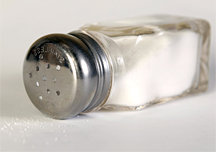Shake-Down on Salt
By Editorial Staff
Let's face it, salt is a pervasive element of the American diet. In fact, many people automatically reach for the salt shaker before they even taste their food. And if you eat out a lot, you can be sure that you are ingesting a great deal of sodium. Too much sodium can increase your blood pressure and your risk of suffering a stroke, but fortunately, there are simple solutions to help control your intake.
The most effective strategy is to cook food at home as often as possible, using fresh fruits and vegetables, grains, low-fat dairy products, fresh meat, poultry and fish. If a recipe calls for salt, use it sparingly and maximize flavor with spices and other flavor-enhancers instead. Here are some other tips to salt away about your sodium intake:
Shop smart. Choose sodium-free, low-sodium or no-salt-added convenience foods. Sometimes organic versions of packaged foods are lower in sodium than regular and reduced-sodium versions (but not always). Reading the Nutrition Facts Panel is an easy way to gauge the amount of sodium in a food. If an item contains more than 20 percent daily value (DV) of a nutrient, a serving of that food is considered to contain a high amount of that nutrient, according to the FDA. Five percent DV of a nutrient is deemed low. For sodium, 20 percent DV equals 460 mg of sodium, while 5 percent DV is just 115 mg.
Watch out for lower-fat foods. Lower-fat or fat-free products can be higher in sodium than their full-fat counterparts. An ounce of full-fat sharp cheddar cheese has less sodium than 1 ounce of fat-free cheddar. When fat, a major flavor-enhancer, is removed, other ingredients such as sodium are often added to compensate.
Cook sensibly. You also can control your sodium intake when cooking. Rinse and drain canned foods to wash away some of the salty components in the packing juices, even if you can't eliminate additives the food may have already absorbed (see below). When cooking starches or grains, don't salt the water, so the noodles or rice don't absorb additional sodium dissolved in the liquid. Marinating is a smart way to infuse meats and fish with flavor without loading up on salt.
 Beware of hidden ingredients. Cake mixes, flavored milks, lunch meats, jarred condiments and snack foods may include ingredients that add sodium. The tricky part is that many of these foods may not taste salty. Here are just a few of the many forms sodium can take:
Beware of hidden ingredients. Cake mixes, flavored milks, lunch meats, jarred condiments and snack foods may include ingredients that add sodium. The tricky part is that many of these foods may not taste salty. Here are just a few of the many forms sodium can take:
- Disodium guanylate (flavor enhancer)
- Disodium inosinate (flavor enhancer)
- Sodium alginate (thickener)
- Sodium benzoate (preservative)
- Sodium bicarbonate (texture enhancer)
- Sodium citrate (pH influencer)
- Sodium hydroxide (pH influencer)
So, now that you have the facts, always think about your salt before you shake!
Bean Counters
Here's an example of how the same legume can have vastly different sodium content depending on how its packaged and prepared. And keep in mind that before you buy, always check labels, as different brands may vary slightly.
1 (15.5-ounce) can black beans, drained = 859 mg
1 (15.5-ounce) can black beans, rinsed and drained = 815 mg
1 (15.5-ounce) can 50%-less-salt black beans, rinsed and drained = 780 mg
1 (15-ounce) can organic black beans, rinsed and drained = 420 mg
1 (15-ounce) can unsalted black beans, rinsed and drained = 90 mg

